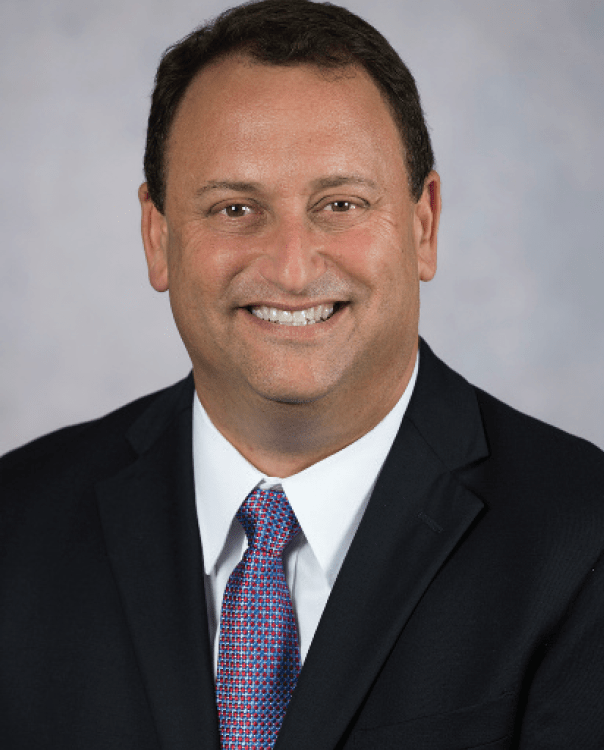Tampa General Hospital (TGH) is a private, not-for-profit hospital on Tampa’s Davis Islands. Part of the fabric of the community for nearly 100 years, TGH is the primary teaching hospital for the USF Health Morsani College of Medicine and has a deep and rich history of working together with both academic and community physicians.
As a Level I Trauma Center,Tampa General Hospital was named the #1 hospital in Tampa Bay byU.S. News & World Report 2017-2018, and recognized as one of America’s Best Hospitals in six specialties. In addition, TGH has earned and maintained Magnet status – the highest recognition a hospital can receive for nursing excellence – since 2005.
As one of the most comprehensive medical facilities in West Central Florida, TGH serves 12 counties and is one of the largest hospitals in Florida, licensed for 1,010 beds. It’s one of the region’s largest employers, with more than 8,000 team members.
John Couris, TGH’s new president and CEO, took over the reins of TGH in August 2017, just in time for Hurricane Irma. He saw firsthand how well the team worked, seamlessly executing their disaster plan. He knew he had made the right decision to become their leader. “They did an amazing job, and our patients were never in jeopardy,” Couris said.
It’s that teamwork, he believes, that is the essence of an outstanding hospital like TGH. “The recognition fromU.S. News & World Report reflects our commitment to quality, and proves that the efforts of our team members really makes a difference,” Couris
said.
TGH is providing world-class health care, using cutting-edge technology and procedures, in a safe, patient-friendly environment. TGH performed Florida’s first heart transplant more than 30 years ago and is now one of the busiest organ transplant centers in the nation; by the end of 2018, TGH will have performed more than 10,000 transplants. New devices are being used to save patients’ lives and improve their health every day. Need a pacemaker the size of a multi-vitamin? A tiny tube that can vacuum out what once was considered a catastrophic blood clot? You can find them – and more brand-new and investigational technology – at TGH.
It’s that innovation and exceptional patient care that Couris hopes will pave the way for TGH’s vision and development.
dR: Why has TGH started a telehealth initiative?
JC: We understand our patients are busy and that it’s hard to drop everything to come to the doctor’s office. That’s why we’re using technology to come to them. Our providers are using our TGH Virtual Care service to make it as easy and convenient as possible for our patients to get the care they need – no matter where they’re located.
dR: Tell us about TGH’s leading services.
JC: We have one of the largest transplant programs in the country with outstanding results, thanks to our multidisciplinary team. We are the only Level I Trauma Center on the West Coast. We are one of three verified burn centers in the state of Florida. Thanks to our academic partnership with the USF Health Morsani College of Medicine, we have 330 residents and fellows and hundreds of allied health professionals that we train every day, as well as a robust research platform with over 400 clinical trials. Last year, we did 32,000 surgeries and 500 transplants.
dR: Tell us about your plans for TGH.
JC: We are creating a patient-centered system of care. Everything we do is organized around the patient. We want to create an environment that is seamless, transparent and intuitive for the patient -so the patient doesn’t have to worry about how to coordinate services; we coordinate services for them. We need to continue to invest in new technology and new programs and new infrastructure, such as new operating rooms and new imaging technology. We continue to collaborate with our physicians on best practices. To enhance patient care, we are moving to a service line orientation: for example, we are organizing around the patient journey from the outpatient world, inpatient world and post-acute world to services such as women’s and children, cancer care, cardiology, neuroscience, transplant, orthopedics, health and wellness, thyroid and parathyroid, and imaging. Our plan is to continue expanding into the community to provide high quality care and easier access to our patients.
dR: How do you keep your finger on the pulse of TGH?
JC: A couple of times a month, I put on scrubs and work alongside the staff — cleaning floors, transporting patients, and working in the emergency room or operating room. When you walk in your team members’ footsteps, you see the world through their eyes and better understand their experiences in the organization. This allows me to get to know people and builds anesprit de corps that’s critical. My approach is that I want to be authentic, genuine and transparent. I want to inspire the team to be the best they can be. If you have happy, engaged team members who feel supported and listened to, and their issues are being resolved, you ensure that your patients receive world-class care.
dR: How do you connect with the staff about TGH news?
JC: I meet with our leadership team monthly and host hospital-wide communications forums several times a year. Once a month I make a video for our team members. We call it “Out and About with John,” and each month I go to a different department and talk to them about a new innovation they have introduced. For instance, I just highlighted TGH’s Level IV Neonatal Intensive Care Unit (NICU). They have installed web cams for every baby – and that’s nearly 100 beds. Thanks to these cameras, when parents and family members can’t be at the NICU, they can go online 24/7 with secure access and a private password so they can see their baby. Maybe there’s a military parent stationed overseas, or grandparents in a distant state. No matter what their challenges are, we can provide them a little more peace of mind.
dR: What do the next five years look like for TGH?
JC: We’re shifting paradigms. We have to stop thinking of ourselves as being in the sickness business and realize that we’re in the health and wellness and care coordination business.
Once we focus our thinking that way, we can organize our resources and technology around the patient, not the other way around. We want to lower costs and drive quality up. The next five years will be exciting and fast-paced—we are going to flourish by disrupting the entire health care market through innovative technology and programs that all center on driving real value to
the patient.




